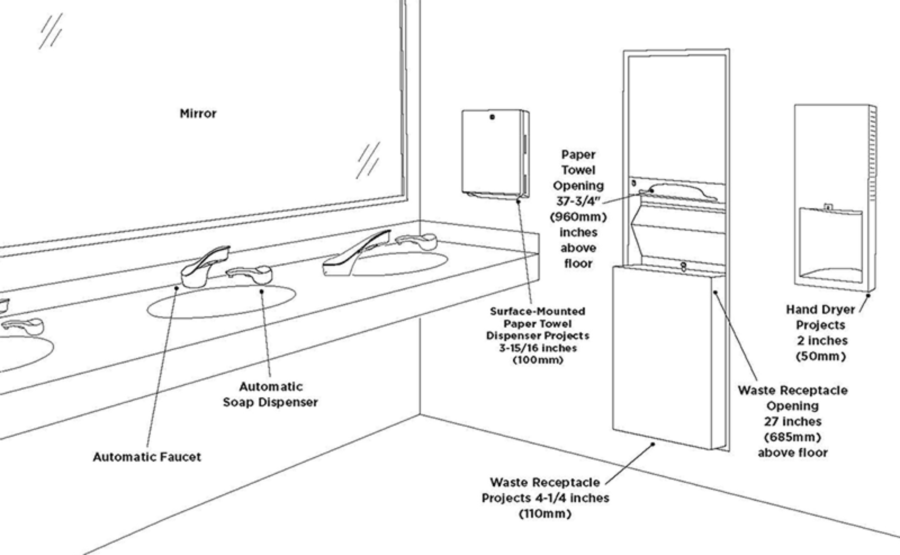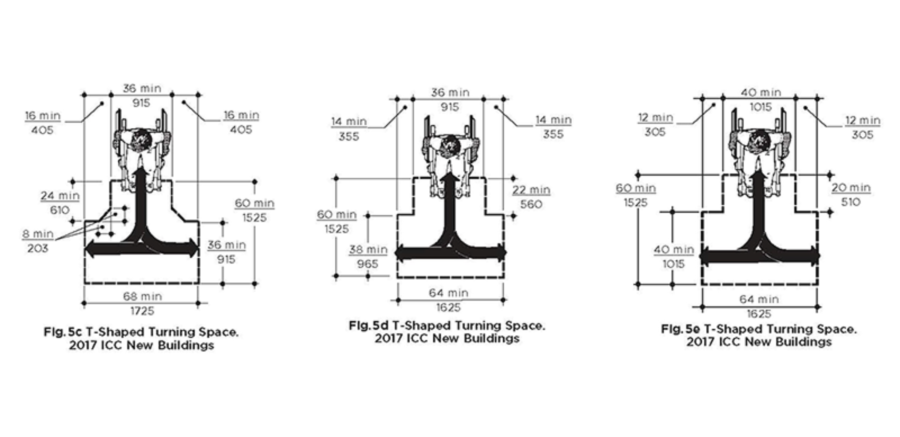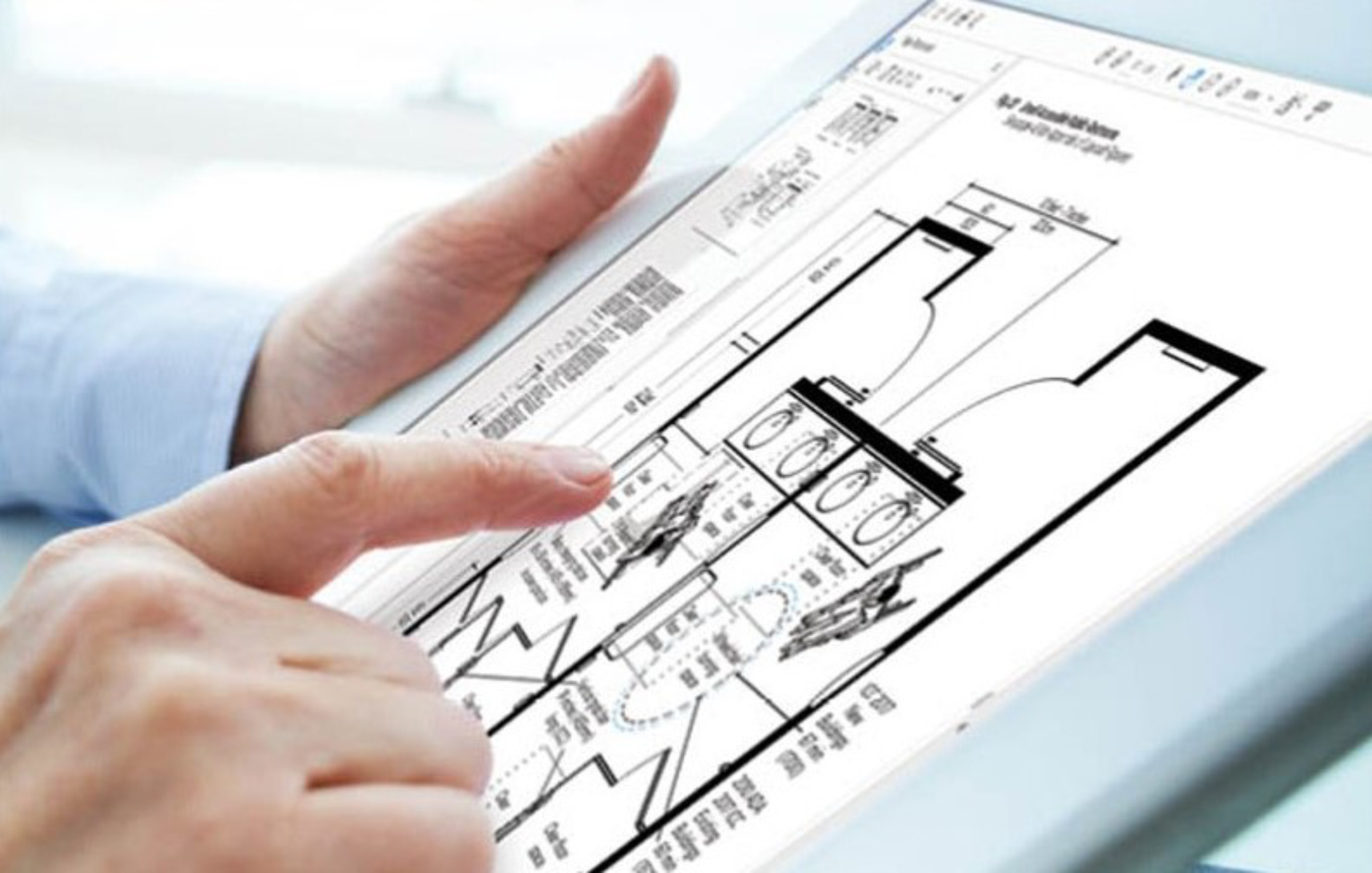As architects and designers work to keep up with green building standards, they must also be sure they’re following accessibility provisions.
The Americans with Disabilities Act (ADA) was signed into law by President George H.W. Bush in 1990. Since then, Bobrick has been committed to providing the most up-to-date information on accessible and compliant restroom design.
While the 2010 ADA Standards have not changed, we are pleased to continue our Planning Guide for Accessible Restrooms with a fourth edition. This 2022 update includes important changes that come from the 2017 edition of ICC A117.1 2017, Standard for Accessible and Usable Buildings and Facilities.
Implementing accessibility standards can be beneficial for green building designers. These types of provisions can reduce the need for renovations and help extend the building’s lifespan.
Accessibility Standards

The 2017 ICC Standards require altered installation heights and locations for paper towel dispensers and hand dryers—at or near an accessible lavatory—where reaching is obstructed, such as units mounted on perpendicular walls adjacent to accessible lavatories. The operable portions of these elements may need to be installed as low as 34 inches (865 mm), depending on how far back from the front edge of a lavatory or counter a unit is mounted. Image courtesy of Bobrick
ADA sets the minimum requirements—both scoping and technical—for newly designed and constructed or altered state and local government facilities, public accommodations, and commercial facilities to be readily accessible to and usable by individuals with disabilities.
In restroom design, this means some of each type of fixture or feature—as well as the installation location—must meet accessibility requirements. When it comes to accessibility, there are a number of provisions that architects, designers, specifiers, building owners, and property managers must follow. These provisions are found in two primary sources:
- 2010 ADA Standards for Accessible Design (referred to as 2010 ADA Standards)
- 2017 Edition of ICC A117.1, Accessible and Usable Buildings and Facilities (certified by the American National Standards Institute or ANSI and referred to as 2017 ICC Standards).
Bobrick’s Planning Guide released in February 2022 breaks down 13 key changes including dimensional requirements for new buildings.
What’s New

Image courtesy of Bobrick
In this edition, we’ve added new features to make it easier to understand, including a table of contents and numerous new illustrations.
Below is a breakdown of additional key updates available in the planning guide for accessible restrooms.
Reference to ICC A 117.1—2017 Accessibility Standards: For the first time, the 2017 ICC standards make a distinction between some dimensional requirements for new buildings and existing buildings.
Federal Buildings: Not covered by the ADA, federal buildings follow the provisions of the Architectural Barriers Act (ABA), and we’ve created a section that addresses this.
Hygiene, Health, and Wellness: After accessibility compliance, restrooms should be designed and maintained to support hygiene best practices.
Shifting Demographics: A significant shift in demographics has occurred since the ADA was put into law.
Multigenerational Restrooms: As the US becomes increasingly diverse, facilities must accommodate by becoming more inclusive as the Multigenerational Restrooms section indicates.
Clear Floor Spaces: A wide variety of changes have been made to the 2017 ICC Standards for new buildings based on the increased size of three basic space requirements, wheelchair clear floor space, circular wheelchair turning space, and T-shaped wheelchair turning space.
Obstructed Reach Range Solutions: The 2017 ICC Standards require altered installation heights and locations for paper towel dispensers and hand dryers installed adjacent to accessible lavatories. Additionally, the 2017 ICC Standards require that soap dispenser controls and faucets that serve certain accessible lavatories—in larger restrooms determined by scoping such as IBC to require an enhanced reach range—need to be installed at a certain reach depth.
Alternate Wheelchair Accessible Toilet Compartment: The 2017 ICC Standards include a new Alternate Wheelchair Accessible Toilet Compartment to accommodate wheelchair use.
Ambulatory Accessible Toilet Compartment: The 2010 ADA Standards and the 2017 ICC Standards now both require 35 to 37 inches wide compartment interior dimensions to accommodate the needs of people who are ambulatory. Additional requirements including toilet placement, an outswing door, and other features are outlined for complete design
Toe Clearance: Toe Clearance has been increased in the 2017 ICC Standards, while the toe clearance for the 2010 ADA Standards remains the same.
Full Height Partitions: There is an increasing interest in full-height partitions for improved privacy, and the 2017 ICC Standards for these partitions are addressed in detail with illustrations.
Exception added to Toilet Tissue Dispensers: Updated specifications on the optional placement of toilet tissue dispensers.
Individual Toilet Room with Adult Changing Station: An adjustable-height adult changing station can be located in individual toilet rooms.
Transfer Shower Compartments: The clear floor space changes in the 2017 ICC Standard also apply to the space requirements in front of a transfer shower. There are specific dimensions outlined for new and existing buildings to satisfy 2017 ICC and 2010 ADA Standards.
Signage: Specifications of using the International Symbol of Accessibility (ISA).
Layout figures: We’ve provided full illustrations of these new changes with and without Bobrick product recommendations.
Helping architects navigate design changes in restroom accessibility has been a 30-year mission for Bobrick. We work with a wide variety of experts to interpret these changes so we can continue to be a trusted partner for architects in restroom design.
If you’re familiar with a previous edition of the Planning Guide for Accessible Restrooms, our 2022 edition will be even easier to digest. Changes in standards for restroom accessibility are inevitable, but Bobrick continually monitors industry updates for future planning guides.


